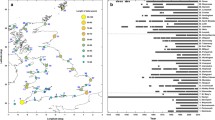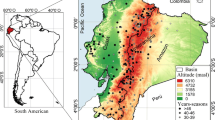Abstract
Thirty La Niña events have been selected from monthly mean sea surface temperature (SST) data of the Hadley Centre Global Sea Ice and Sea Surface Temperature (HadISST) and Centennial Observation-Based Estimates (COBE SST2) datasets from 1870 to 2013 based on a criterion of –0.5°С for a cold anomaly in the Niño 3.4 region (5° N–5° S, 170°–120° W) and its minimum duration of 5 months. The selected events are classified by hierarchical clustering analysis according to two characteristics: geographic coordinates and SST anomalies during the mature phase of La Niña. The objective classification method identifies two types of La Niña differing by the evolution of negative SST anomalies in the equatorial Pacific and by the Southern Oscillation Index.
Similar content being viewed by others
References
S. G. Philander, El Niño, La Niña and the Southern Oscillation (Academic, San Diego, 1990).
M. J. McPhaden, S. E. Zebiak, and M. H. Glantz, “ENSO as an integrating concept in earth science,” Science 314 (5806), 1740–1745 (2006).
K. E. Trenberth and J. M. Caron, “The Southern Oscillation revisited: Sea level pressures, surface temperatures and precipitation,” J. Clim. 13, 4358–4365 (2000).
A. Singh, T. Delcroix, and S. Cravatte, “Contrasting the flavors of El-Niño–Southern Oscillation using sea surface salinity observations,” J. Geophys. Res. 116, C06016 (2011).
Catalogue of Indices and Definitions of El Niño and La Niña in Operational Use by WMO Members, WMO Commission for Climatology CCl-XIII (2005), Expert Team on El Niño and La Niña Definitions (World Meteorological Organization, Geneva, 2006).
M. H. Glantz, A La Niña Summit: A Review of the Causes and Consequences of Cold Events (Environmental and Societal Impacts Group, NCAR, Boulder, Colorado, 1998).
B. Wang, “Interdecadal Changes in El Niño onset in the last four decades,” J. Clim. 8, 267–285 (1995).
K. Ashok, S. K. Behera, S. A. Rao, et al., “El Niño Modoki and its possible teleconnection,” J. Geophys. Res. 112, C11007 (2007).
H. Y. Kao and J. Y. Yu, “Contrasting Eastern-Pacific and Central-Pacific types of ENSO,” J. Clim. 22, 615–632 (2009).
S. W. Yeh, J. S. Kug, B. Dewitte, et al., “El Niño in a changing climate,” Nature 461, 511–514 (2009).
Y. Yuan and S. Yang, “Impacts of different types of El Niño on the East Asian Climate: Focus on ENSO Cycles,” J. Clim. 25, 7702–7722 (2012).
J. S. Kug, F. F. Jin, and S. I. An, “Two types of El Niño events: Cold tongue El Niño and warm pool El Niño,” J. Clim. 22 (6), 1499–1515 (2009).
H. L. Ren and F. F. Jin, “Niño indices for two types of ENSO,” Geophys. Res. Lett. 38, L04704 (2011).
W. Cai and T. Cowan, “La Niña Modoki impacts Australia autumn rainfall variability,” Geophys. Res. Lett. 36, L12805 (2009).
T. Shinoda, H. E. Hurlburt, and E. J. Metzger, “Anomalous tropical ocean circulation associated with La Niña Modoki,” J. Geophys. Res. 116, C12001 (2013).
Y. Yuan and H. M. Yan, “Different types of La Niña events and different responses of the tropical atmosphere,” Chin. Sci. Bull. 58 (3), 406–415 (2013).
W. Zhang, L. Wang, B. Xiang, et al., “Impacts of two types of La Niña on the NAO during boreal winter,” Clim. Dyn. 44, 1351–1366 (2014).
N. A. Rayner, D. E. Parker, E. B. Horton, et al., “Global analyses of sea surface temperature, sea ice, and night marine air temperature since the late nineteenth century,” J. Geophys. Res. 108 (D14), 4407 (2003).
S. Hirahara, M. Ishii, and Y. Fukuda, “Centennialscale sea surface temperature analysis and its uncertainty,” J. Clim. 27, 57–75 (2014).
C. F. Ropelewski and P. D. Jones, “An extension of the Tahiti–Darwin Southern Oscillation Index,” Mon. Weather Rev. 115 (9), 2161–2165 (1987).
A. I. Orlov, Non-Numeric Statistics (MZ-Press, Mosocw, 2004) [In Russian].
A. I. Orlov, “Mathematical methods of the classification theory,” Nauchnyi Zh. Kuban. Gos. Agrar. Univ. 7 (91), 1–28 (2014).
N. N. Bureeva, Multidimensional Statistical Analysis with STATISTICA Software Package, A Tutorial on the Professional Development Program “The Use of Software Tools in Scientific Research and Teaching of Mathematics and Mechanics” (Nizhegorodskii Gos. Univ., Nizhny Novgorod, 2007) [In Russian].
B. Laken and J. Calogovic, “Composite analysis with Monte Carlo methods: An example with cosmic rays and clouds,” J. Space Weather Space Clim. 3, A29 (2013).
K. E. Trenberth, “The definition of El Niño,” Bull. Am. Meteorol. Soc. 78 (12), 2771–2777 (1997).
Author information
Authors and Affiliations
Corresponding author
Additional information
Original Russian Text © E.N. Voskresenskaya, O.V. Marchukova, 2017, published in Izvestiya Rossiiskoi Akademii Nauk, Fizika Atmosfery i Okeana, 2017, Vol. 53, No. 1, pp. 125–134.
Rights and permissions
About this article
Cite this article
Voskresenskaya, E.N., Marchukova, O.V. Spatial classification of La Niña events. Izv. Atmos. Ocean. Phys. 53, 111–119 (2017). https://doi.org/10.1134/S0001433817010133
Received:
Accepted:
Published:
Issue Date:
DOI: https://doi.org/10.1134/S0001433817010133




